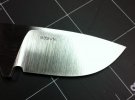- Joined
- Feb 17, 2009
- Messages
- 7,310
So many great knifemakers out there. You see all sorts of plunge lines on the variety of blades being made.
What kind of plunge line do you prefer and how do you decide what style to use ie. Straight, Slanted, sweeping etc.?
Currently I like a straight plunge line on most the blades I make. I like the way it lines up with the handle and makes a nice rectangular ricasso.
So what say you?
What kind of plunge line do you prefer and how do you decide what style to use ie. Straight, Slanted, sweeping etc.?
Currently I like a straight plunge line on most the blades I make. I like the way it lines up with the handle and makes a nice rectangular ricasso.
So what say you?



